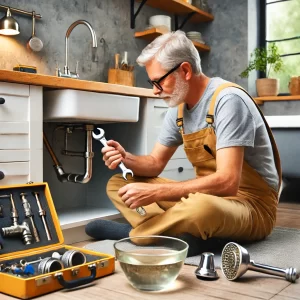The Homeowner’s Guide to Basic Plumbing Maintenance

Maintaining your home’s plumbing system is crucial to prevent minor issues from escalating into costly repairs. Regular upkeep not only extends the life of your plumbing but also ensures everything runs smoothly, saving you from unexpected disruptions. Here’s a straightforward guide for homeowners on basic plumbing maintenance that you can do yourself to keep your system in top shape.
1. Regularly Check for Leaks
Small leaks can lead to big problems if they go unnoticed. Regularly inspect under sinks, around toilets, and near appliances for signs of leaks. Look for moisture, small drips, or discoloration of walls and flooring. Catching a leak early can save you from water damage and costly repairs.
2. Clean Faucets and Showerheads
Mineral deposits from water can clog your faucets and showerheads, reducing water flow and efficiency. Unscrew these fixtures periodically and soak them in vinegar overnight to dissolve the buildup. Rinse and reattach them in the morning for improved water pressure and flow.
3. Know How to Use Your Main Water Valve
In case of a major leak or a burst pipe, it’s crucial to know where your main water shut-off valve is located and how to operate it. Turning off the water quickly can prevent extensive water damage and give you peace of mind when you’re away from home for an extended period.
4. Inspect Toilet Tank and Bowl for Integrity
Check your toilet for hidden issues like a worn out flapper or malfunctioning fill valve, which can cause phantom flushes or a continuously running toilet. These issues not only waste water but can also increase your water bill significantly. Replacement parts are inexpensive and available at most hardware stores.
5. Use Strainers in Drains
Prevent clogs by using strainers in kitchen sinks, showers, and tub drains to catch hair and other debris. Cleaning these strainers regularly will help keep your drains clear and free-flowing.
6. Avoid Chemical Drain Cleaners
While it may be tempting to use chemical drain cleaners for clogs, these can often do more harm than good. They can corrode your pipes and cause leaks over time. Instead, use a plunger or a plumber’s snake to mechanically remove clogs, or opt for a natural solution like baking soda and vinegar.
7. Flush Your Water Heater Annually
Sediment can build up in your water heater tank, reducing its efficiency and lifespan. Flushing it once a year can help prevent this buildup and keep it running efficiently. This is also a good time to check the anode rod and replace it if necessary to prevent rust and corrosion.
8. Inspect Outdoor Faucets and Hoses
Before the cold season hits, make sure to inspect and drain outdoor faucets and hoses to prevent freezing and bursting pipes. Install frost-proof outdoor faucets or cover existing ones with insulated covers to protect them from freezing temperatures.
9. Schedule Professional Inspections
Even with diligent maintenance, it’s wise to have your plumbing system professionally inspected at least once a year. Plumbers can spot potential problems you might miss and can ensure that everything is in optimal working condition.
10. Keep a Basic Plumbing Toolkit
Having the right tools can make DIY plumbing maintenance easier. Your toolkit should include basics like a plunger, adjustable wrench, screwdriver, plumber’s tape, and a flashlight. These tools will prepare you for basic repairs and maintenance tasks.
By following these simple tips, you can keep your plumbing system healthy and avoid the hassle of unexpected plumbing disasters. Regular maintenance not only preserves the integrity of your plumbing but also ensures your home runs more efficiently. Remember, when in doubt about a plumbing issue, it’s always best to call in the professionals.